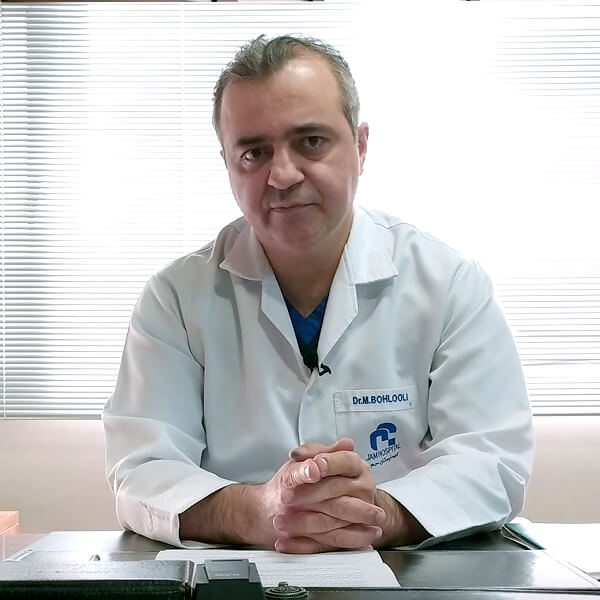Dr. Iman Mohammadpour
Surgeon and Specialist in Bone and Joint Diseases and Subspecialist in Spine Surgery
Dr. Iman Mohammadpour, Surgeon and Specialist in Bone and Joint Diseases and Subspecialist in Spine Surgery, explains about Bone and Muscle Tumors.
The text of Dr. Mohammadpour’s speech
Hello, I am Dr. Iman Mohammadpour, a surgeon and specialist in bone and joint diseases at Jam Hospital. Today we intend to talk about bone and muscle tumors in the upper and lower regions.
The most important way to diagnose tumors that involve bones and muscles of the limbs, in the early stages, a complete history and examination are sufficient to make us suspicious of whether there is a problem or not. Usually, people with bone and muscle tumors visit us with pain or the presence of a mass and swelling in the limbs.
Many times these tumors are discovered by accident, that is, we are looking for another problem, for example, the patient has had an accident, or has ankylosing spondylitis. We take an X-ray and in those X-rays, we see that the patient has a bone tumor. But usually, the tumors that involve the bone itself have the most severe symptom of pain. That is, the patient visits us with pain and complains of pain in the bone. In the early stages, this pain can start with activity but with the progression of the tumor and the prolongation of the disease, the patient may also complain of nighttime and resting pain.
Muscle tumors and tumors that do not involve the bone usually do not have pain. That is, the patient does not complain of pain and complains of the presence of a mass in the upper and lower limbs. He visits us and says that he has felt a lump in one of his muscles for about a month. So soft tissue tumors do not have pain, except in exceptional cases.
For example, tumors that originate from the nerve sheath and grow can become painful. But generally, tumors of the muscles of the upper and lower limbs do not have pain. So we must pay attention to the fact that just because they do not have pain, we should not say it is not important. As soon as we notice something abnormal in the limbs, we must visit a doctor.
There are several criteria for diagnosing these tumors. For example, gender is not very important. Many tumors have equal incidence rates between men and women. Many, but not all. Or race is not very important. It is not related to a specific race, except in exceptional cases. So race or gender are not very important factors and do not help us much. But one important factor for diagnosing bone tumors is age.
Age is very important for us because many benign and malignant bone tumors or even soft tissue tumors, occur in a specific age range and for example after the age of growth and childhood, we usually no longer see certain tumors. So age is very important for our diagnosis.
Now, if we suspect a bone tumor after the relevant examinations, our first step is to take an X-ray. A simple X-ray that is available everywhere can give us the most important and complete information. So our first step is to take an X-ray in frontal and lateral views and based on that X-ray and the patient’s age range, we can diagnose whether the tumor is benign or malignant or if it needs further investigation. Now if we see on the image that the tumor has destroyed the cortex of the bone, which is the thick part of the bone, or has created a new bone formation, these make us suspect that the tumor seen in the image might be malignant.
Radiography might not be very helpful in soft tissue tumors of the limbs, but it must definitely be taken. For diagnosing soft tissue tumors, it is not very helpful. A CT scan can help a lot because it shows the bone details very well and can help us diagnose lung metastases.
If we want to see whether our tumor is active or not, that is, is the tumor growing in terms of the cell cycle? Or is this tumor only in this area or has it involved other parts of the body in terms of the skeletal system? Bone scan is very helpful for us in these cases.
MRI shows the extent of the tumor very well, both bone and soft tissue. And it can tell us how close this existing tumor is to vital elements such as arteries and nerves. But MRI cannot tell us whether this tumor is benign or malignant.
This issue also has a few exceptional cases that we do not need to get into. If we put aside the bone tumors themselves, there are other cancers that invade the bone and metastasize. One of the most common tumors that metastasize to the bone are prostate and breast tumors. That is, patients with prostate or breast tumors may in the advanced stages of the disease metastasize to other parts of the bone and spread. But if we see a bone metastasis that does not have a clear origin and despite our searches for prostate or breast issues, there is none, it can be from the lung or kidney.
And now the treatments for bone tumors. Benign bone tumors that are discovered by chance if they have not weakened the bone have not weakened the cortex, we are not suspicious of a fracture, and based on our diagnosis, we conclude that there is no risk of fracture for the patient, we may not even treat it. Instead, we can follow it up and some of them can disappear over time. But bone tumors that we suspect to be malignant have very different treatments.
The most important method to diagnose the type of bone tumors is biopsy. That is, we must take a mass from that tumor, test it, and based on that, apply the treatment protocol for the patient. Unfortunately, bone tumors are usually resistant to radiotherapy. That also has a few exceptions that we do not deal with. So many bone tumors cannot be treated with radiotherapy because it does not work. Tumors originating from cartilage, such as osteosarcoma, are resistant to chemotherapy as well. However, tumors that metastasize to the bone from elsewhere are sensitive to radiotherapy, except for kidney ones.
After we do a biopsy and determine what type of tumor we have to start the treatment protocol, it is usually the case that before surgery, we perform a round of chemotherapy to reduce the size of the tumor, make its removal easier, and reduce the spread of bone tumors during surgery.
The patient undergoes a round of chemotherapy, then give a three to four-week stop, and then surgery is performed. Two weeks after the surgery when the wounds have started to heal, we resume chemotherapy. But in the case of benign bone tumors that we think are prone to fracture, we must remove that tumor and fill the defect area with either bone or cement. Or other measures. For example, if a plate is needed or a cast is taken, we support it until the treatment process is complete.
Thank you very much.




